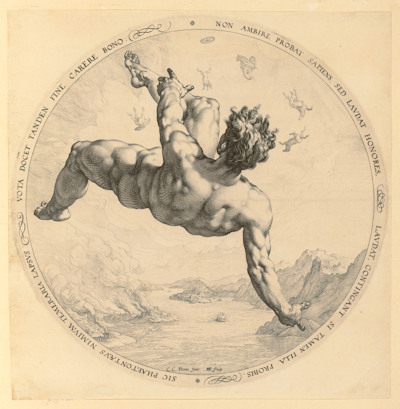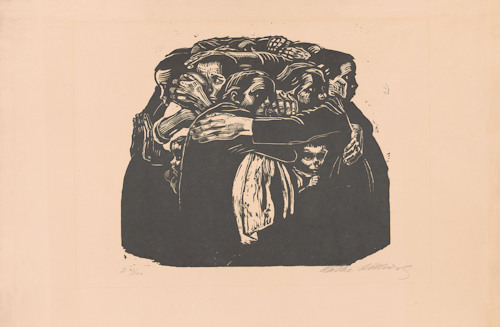
As the grey skies of winter give way to spring sunshine, the Albertina has a celebratory treat for us: an exhibition tracing the great masters of printmaking through the centuries.
- Numerous notable names & their works
- Draws on the extraordinary in-house collection
- Runs Jan 27 – May 14, 2023
- See also:
- Albertina overview & info
- Other art exhibitions in Vienna
Masters of Printmaking

(Hendrick Goltzius; Phaeton, 1588; copperplate engraving; photo courtesy of and © The Albertina Museum, Vienna)
Dürer, Munch, Miró: the Great Masters of Printmaking is the first of two exhibitions marking the 20th anniversary of the Albertina’s reopening in 2003.
The exhibition features works from the in-house archives, which date back rather longer than 20 years.
When a museum draws largely on its own collections, the jaded observer might wonder about the likely quality. Not, though, when that collection is the one at the Albertina museum.
Imagine Wimbledon presenting the great tennis players of the past only using photos taken at their own tournament. They’d probably manage.
Duke Albert of Saxe-Teschen began everything back in the late 1700s. His and later acquisition efforts have produced a huge resource that includes over a million drawings and prints.

(Edvard Munch, self-portrait (with skeleton arm), 1895; lithograph with lithographic chalk; photo courtesy of and © The Albertina Museum, Vienna)
Which brings us back to Dürer, Munch, Miró, and friends.
The exhibition traces the evolution of graphic prints from the efforts of the late Middle Ages through to the 20th century. (Pop art and later implementations appear in the sister exhibition at the Albertina Modern.)
It all begins with a rare 14th-century woodcut and startling examples by Martin Schöngauer from the early 1470s. His engraving The Temptation of St. Anthony has a clarity and Bosch-like sense of imagination.
What then follows, while not intended as comprehensively chronological, takes us through centuries of artistic and technological developments featuring prints by a panoply of art greats.
So we encounter Albrecht Dürer (including his iconic 1515 rhino) and Pieter Bruegel the Elder.

(Albrecht Dürer, Das Rhinozerus, 1515, woodcut and letterpress, courtesy of and © the Albertina Museum, Vienna)
Rembrandt and Goya (including etchings from his The Disasters of War series).
Canaletto, Édouard Manet, and Hogarth (to warm an English heart).
Posters by Toulouse-Latrec and studies by Edvard Munch (like his 1902 The Kiss IV woodcut).
Then on to dip into works by Pierre Bonard, Max Klinger, and Paul Klee.
Chagall, Matisse, Kollwitz, and even David Hockney. And many more!

(Käthe Kollwitz, Die Mütter (Krieg, Blatt 6), 1922/1923, woodcut, courtesy of and © the Albertina Museum, Vienna)
What remains from a viewing?
For me, an admiration for the artists’ ability to overcome the limitations of technology to produce works full of expression and/or clarity. Miracles arise from mere lines and areas of light and dark.
An appreciation for the medium. Those (like me) unversed in art history my be surprised by the names above.
The links to the past in more recent print works. Ernst Fuchs’s 1949 May Picture, for example, carrying echoes of those Renaissance efforts from a few rooms earlier.
And the synergy between technology and artistic advances. Side-by-side comparisons of a woodcut with the chiaroscuro version, for example, bring that home.
All-in-all a deserving tribute to the Albertina collection.
Dates, tickets & tips
Enjoy a journey through the master artists of printmaking history from January 27th to May 14th, 2023. Any entrance ticket from or for the Albertina includes the exhibition.
Different print techniques can become confusing. The exhibition offers some help, for example, through explanatory videos. But a quick revision of terms like woodcuts, etchings, engravings, chiaroscuro, and lithographs might give you an even fuller appreciation of the works on display.
As mentioned, the Dürer, Munch, Miró exhibition forms one half of an event duo. The Andy Warhol to Damien Hirst exhibition runs concurrently at the Albertina Modern from February 24th.
But the spring treats don’t end there.
For example, the Albertina itself has the Bruegel and his Time exhibition from February 15th, with drawings by this icon and his contemporaries.
And if we’re dropping into Renaissance Flanders, then pop into the Kunsthistorisches Museum. It just happens to have the world’s largest collection of paintings by Pieter Bruegel the Elder. You’ll find Dürer and others there too, of course.
How to get there
The Albertina is one of those museums you wander past on any meander around Vienna’s centre, but look for the travel tips at the bottom of the main museum article.
Address: Albertinaplatz 1, 1010 Vienna